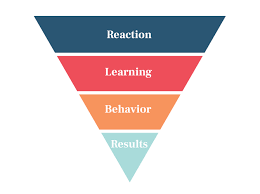
In the landscape of training and development, one method has stood the test of time in helping organizations evaluate the effectiveness of their training programs—the Kirkpatrick Model. Developed in the 1950s by Dr. Donald Kirkpatrick, this model has provided a structured four-level framework that can be leveraged to gain insights into the influence and impact of training initiatives.
At its core, the Kirkpatrick Model breaks down evaluation into four distinct levels: Reaction, Learning, Behavior, and Results.
Level 1: Reaction
This level gauges how participants respond to the training. Are they engaged? Do they find it relevant and useful? Evaluation tools commonly employed at this stage include post-training surveys, feedback forms, and verbal reactions. Measuring reaction is critical because it helps trainers understand if the material connects with learners and whether it’s conducive to a positive learning environment.
Level 2: Learning
Moving beyond initial reactions, at Level 2 the focus shifts to what extent participants have actually learned from the training—knowledge gained, skills improved, or attitudes changed. This is measured through assessments such as tests or simulations before and after training. It’s vital for ensuring that the content delivered is not only consumed but understood and retained by learners.
Level 3: Behavior
The third level assesses if there’s been a change in behavior due to the training when learners return to their work environments. Essentially, it’s concerned with application: are trainees using their new knowledge and skills on the job? This can be quantified through observations and interviews over time following the completed training.
Level 4: Results
Finally, Level 4 looks at the broader outcomes of the training. This includes organizational results such as higher productivity, improved quality, increased sales, reduced costs, higher employee retention rates, or any other relevant metrics. At this stage, analytics play a crucial role in correlating training efforts with business outcomes.
The incorporation of learning analytics enriches the Kirkpatrick Model by contributing data-driven insights. Learning analytics use data collected during training and from ongoing performance metrics to provide a deeper understanding of how effective training programs are over time. They allow organizations to identify patterns and relationships between variables like learner engagement at Level 1 and changes in performance at Level 4.
This integration also supports more personalized learning experiences as organizations can tailor their programs based on observed results from past cohorts. It aligns well with modern e-learningplatforms where extensive amounts of data can be collected unobtrusively during a learner’s interaction with digital content.
To sum up, The Kirkpatrick Model remains influential because it promotes an evidence-based approach to understanding the full impact of educational interventions within professional settings. By coupling it with learning analytics in today’s data-rich environment, organizations can paint a clear picture of how individual growth translates into organizational success. With this holistic view, they can refine strategies for workforce development that respond directly to both educational efficacy and business objectives.
